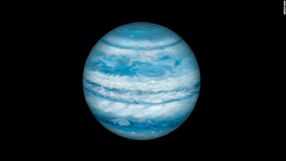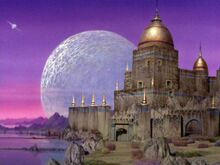
A blue gas giant planet.
A planet, often called a world, was a celestial body that was in orbit around a star, was neither a binary star nor a moon, and had cleared out the area around its orbit as it formed by causing all other smaller bodies in its orbit to accrete with it. As a consequence, it would not share its orbital region with any other bodies of significant size, except for moons or those collected later under its gravitational influence.
Overview[]

The surface of Rigel VII, a populated planet.
There were generally two types of planets known: gas giants and terrestrial rocky worlds. Moons orbiting gas giants and other rocky worlds were usually not considered planets, even though they could be larger or more populated than planets.
Depending on the tilt of its axis, a terrestrial planet might have had varied seasons with changing temperatures and weather, affecting its habitability. Planets were extremely varied in terms of environmental conditions and landscape, ranging from completely oceanic, such as Kahje, to thick arboreal rainforests, such as Sur'Kesh and Palamok. Some planets, like Mars, Klendathu, and Ocampa, were completely barren and desolate, covered in little more than rock and sand. Many Class-M planets, like Earth, Vulcan, Sangheilios, and Janjur Qom, contained a mix of landscapes, with various continents, oceans, and mountains.
Sentience[]
Sentience among planets, while rare, was not unheard of. Solaris, for example, was a planet covered by a sentient ocean.